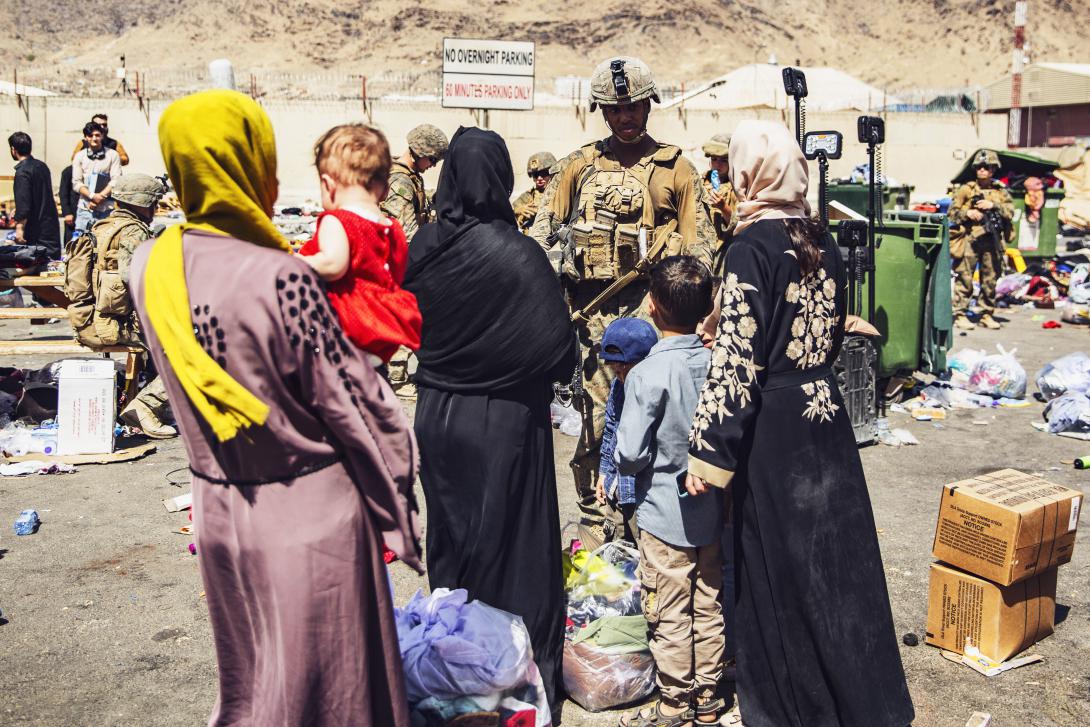Afghanistan Evacuation Data Affects JADC2 Future
Last year’s evacuation of civilians from Afghanistan was a massive undertaking with multiple challenges and successes. The withdrawal required enormous amounts of data, which also presented some obstacles, but ultimately proved successful and offered lessons learned for future operations, according to U.S. Defense Department officials.
The non-combatant evacuation operation (NEO) was the largest such airlift in history. It resulted in 124,000 civilians being evacuated from Kabul in 17 days, including 19,000 in a single day and an average of 7,500 per day. Among those evacuated were 6,000 Americans, according to U.S. Transportation Command statistics. At the height of the airlift, aircraft were leaving every 34 minutes.
Locating and using the vast amounts of data proved challenging, but the efforts taken to overcome those challenges will help shape the military’s concept for joint all-domain command and control, also known as JADC2. The JADC2 vision represents a shift from network-centric to datacentric operations, arguably a historic change for the military.
Lt. Gen. Dennis Crall, USMC, director, command, control, communications and computers/cyber and chief information officer, Joint Staff, J-6, says the data-related challenges included troubles locating the information needed, systems that wouldn’t talk to one another and data storage issues. “A good bit of what we did was discovery learning. We had the data, but we didn’t know where it was. So, we had to go find it,” he reports. “We had processes that were far too labor-intensive that needed to be automated. We had a need for a machine learning or an artificial intelligence layer. We had a need for some level of predictive analytics to look at what was next.”
To provide Gen. Mark Milley, USA, chairman of the Joint Chiefs of Staff, with the information he needed, the J-6 assembled a team of data experts under a special effort known as Project Orsus. The project enlisted support from various data analytic platforms. Those platforms were provided by the Air Force’s Envision program, the Army’s Vantage program, Space Force’s Warp Core, the undersecretary of defense for Intelligence and Security’s Maven program, and the Office of the Secretary of Defense’s Advana. The project connected multiple data sources to provide near real-time information to the Joint Staff and others.
It showed that with “a lot of resolve and a lot of energy, we were able to overcome” the challenges, Gen. Crall says. “We brought in data professionals who could help us write the algorithms to make these machines speak better together. We were able to go through some data storage concerns about how we amalgamate data, where’s the most secure place to keep it, how we build access to it and who we share it with.”
As an example of a challenge that was overcome, Gen. Crall cites the need to track aircraft operating around Kabul. “If you think about how complex it was, how many flights were going in and out, how many flights were from different carriers, from military aircraft to contracted aircraft to commercial aircraft and people being manifested in multiple locations, being flown to these locations before they were brought to the U.S. It’s just a very dynamic communications-challenged environment,” he says.
Figuring out who needed access to that tracking data, assessing confidence levels for the information and then finding it and “automatically pulling it in” added to the challenge, which included “everything from formal reporting of systems to ad hoc systems to chat windows, being able to pull that data in and making that a hands-off process,” Gen. Crall explains. “Over the course of several days, this went from a highly manpower-intensive, low-confidence scoring to something that was much higher in confidence, meaning far more accurate, to a hands-off, automated approach,” he adds.
“What it demonstrates is if the will is there, it can be done.”
Gen. Crall stresses the implications of the Afghanistan NEO for the future of JADC2. “The word I would look at is ‘opportunity.’ Almost every aspect of that NEO involved some small discreet part of JADC2. It was really an opportunity for us to unpack that and look at what was working and what was not working in a very rapid time period.”
Brig. Gen. Robert Parker, USA, deputy director, J-6, and chair of the JADC2 Cross-Functional Team, echoes his boss’s comments. He describes the Afghanistan NEO as “much more than a military operation” and “an exemplar for a study on the JADC2 data problem” from multiple aspects. “That really underscores when we talk JADC2 and data standards, it is understanding not only your authoritative data sources but how you manage and store that, how you access it, how it’s labeled, and then the policies that go along with how you move that in the right ways and release that data to others.”
Charleen “Char” Laughlin, JADC2 Division lead and JADC2 deputy cross-functional team lead, Joint Staff, J-6, describes Orsus as one of the projects she is most excited about. “It was working across the Joint Staff and the combatant commands to be able to track and report near real-time data to the chairman [of the Joint Chiefs of Staff] as we conducted our operations in Afghanistan. The lessons learned out of that really showcased the challenges that we have right now with respect to access to data, the readiness of our data sources and who was able to share that data and see it based on classification.”
The project proved so successful that officials decided to expand it rather than disband it. “There was such an appetite to get that right that we have not disbanded the group that we formed here in the building to do this work. In fact, we’re expanding it, and we’re on to our next problem set,” Gen. Crall says. “We have an effort here in the Pentagon that’s going on today that helps us inform the greater JADC2 way ahead.”
That new focus, he adds, encapsulates a lot, including humanitarian relief, medical community data issues and requests from the chairman of the Joint Chiefs of Staff. “One example would be some of the requests for information from the chairman. When the chairman asks for information on a particular problem set, they could look at that.”
Laughlin agrees that the project will influence JADC2. “That project, which is now focusing on other topics besides Afghanistan, I see as the heart of JADC2, supporting our datacentric approach,” she says. “If we’re not treating our data as a strategic asset—if we don’t understand the quality of it, the readiness of it, and we’re not able to share that across the department—then we’re not all operating from the same level of understanding, which goes back to the very tenet of JADC2, the ability to sense, make sense and then act.”
Project Orsus team members are now working closely with the combatant commands as part of the deputy secretary of defense’s AI (Artificial Intelligence) and Data Acceleration (ADA) initiative.
“What we’re getting from that team is now aligned under the JADC2 Cross-Functional Team to continue to work similar efforts … so that we can better capture those lessons learned and inform the future artifacts that are coming out of the JADC2 Cross-Functional Team—so updates to reference architecture, data standards and policies, our implementation plan,” Laughlin offers.
The ADA initiative includes operational data teams and teams of artificial intelligence experts from the Joint Artificial Intelligence Center, the offices of the chief data officer and chief information officer and others. “ADA is focused on how we scale data and data-enabling technologies to the combatant commands,” Laughlin says. “From where I sit now with the Joint Staff, I can tell you that it’s absolutely critical to talk about how we push resources out to the folks who need it most.”
Brig. Gen. Jacqueline “Denise” Brown, USA, U.S. Indo-Pacific Command’s J-6, or director of command, control, communications and cyber, says the command is one of the first combatant commands to work with the ADA teams. “While we understand that securing data is critical, it must not come at the expense of the visibility, availability or discoverability for the people who need to use it to achieve the decision advantage. That’s going to be probably one of our greatest challenges as we work with the ADA team.”
Gen. Crall suggests that for future operations, teams similar to Project Orsus should be in place beforehand. “What we need to do is create these ahead of time and make sure that we can move these on-call and we get into a habit that allows this type of collection display and gets us out of the manual production business,” he says.








Comments